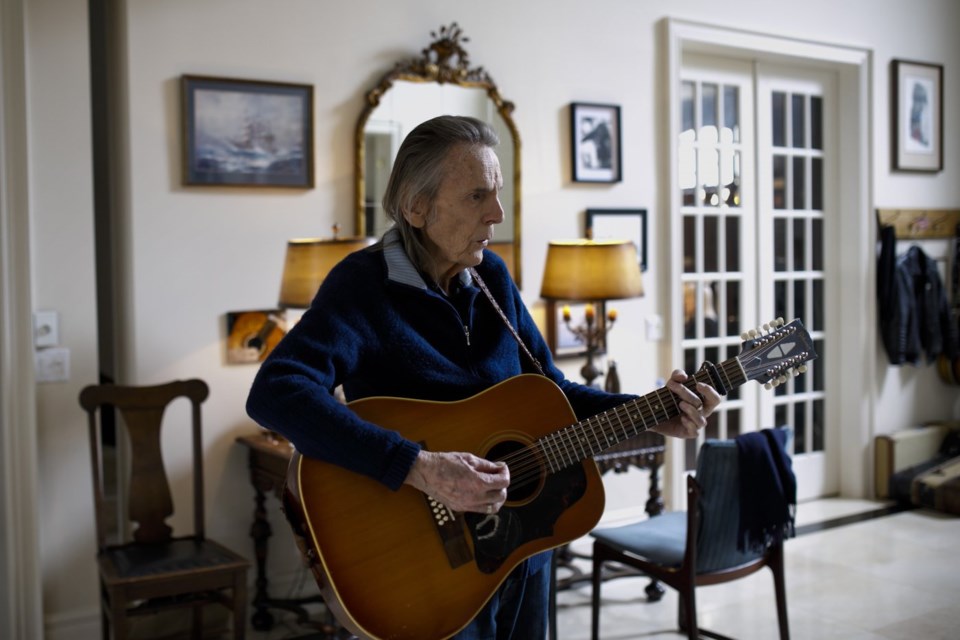Dozens of Gordon Lightfoot's personal belongings ŌĆö including guitars, artwork, even his highest awards ŌĆö are up for grabs in an auction that has some fans questioning why the items weren't rescued by a museum.
Texas-based Heritage Auctions is leading the sale of the artifacts in co-operation with Lightfoot's estate. The auction is currently being held online and closes with an in-person ceremony on Nov. 17, the late musician's birthday.
Among the items being auctioned are nine artist-signed paintings inspired by "The Wreck of the Edmund Fitzgerald" that hung in Lightfoot's living room, and a Rand McNally map of the United States pinned with tour stops that the singer-songwriter also displayed in his home.
There's an array of Lightfoot's most recognizable outfits, a selection of his amplifiers, his sa╣·╝╩┤½├Į's Walk of Fame trophy and his Songwriters Hall of Fame award presented to him in 2012 by Steve Miller.
Some of the guitars in the auction are particularly significant.
His 1967 Gibson B45-12 Sunburst acoustic will be familiar to fans as it was nestled beside Lightfoot on the cover of his 1974 album "Sundown" and used in other photo shoots. The auction house calls it "a vital part of Lightfoot's musical journey."
His 1975 Ed McGlincy acoustic guitar is described as "likely a one-off custom piece" by renowned luthier Ed McGlincy which Lightfoot carried on tour. There's proof of its use in the remnants of tape on its back where he likely stuck his set lists or lyrics during his concerts, it said.
Some fans took to Lightfoot's Facebook page to criticize the auction, saying the estate should have worked with Canadian cultural institutions to protect items that belonged to such a historically important singer-songwriter.
Requests for comment from members of Lightfoot's estate were not returned.
Garry Shrum, the director of music memorabilia at Heritage Auctions who's handled sales of items connected to the Beatles, Elvis and Nirvana, said it's common for fans to bristle at the auction of their favourite artist's items.
"I get that a lot," he said.
"We do have museums that bid in our auctions, and there are people that bid on things and they will loan them to a museum. That type of stuff happens constantly."
Shrum suggested any fans who feel conflicted about the auction should consider viewing the items on the website.
After Lightfoot died last year at the age of 84 there was a groundswell of efforts to solidify his Canadian legacy, such as naming public spaces after him or holding events in his honour, but many never materialized.
Lightfoot's friend and former manager Bernie Fiedler has said the Lightfoot estate shut him out of involvement in a Massey Hall tribute concert earlier this year.
And efforts in Lightfoot's hometown of Orillia, Ont. to consider a museum dedicated to the musician appear to have stalled as well.
City council established a working group to consult with the estate on memorabilia for display, and while an extension to the mandate was approved last fall, no announcements have been made.
Shrum said he was most surprised by the sheer quantity of items available for the Lightfoot collection when he visited the late singer-songwriter's home shortly after his death.
"It was like a museum," he said of the mansion in Toronto's affluent Bridle Path neighbourhood.
"Gordon had all the walls decked out with his whole history."
"Good for him that he didn't throw this stuff away like a lot of people do," he added.
A second auction of Lightfoot's "odds and ends," mostly jewelry, photographs and awards, will go live in mid-November and close on Dec. 7.
This report by The Canadian Press was first published Oct. 29, 2024.
David Friend, The Canadian Press



